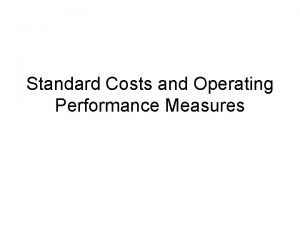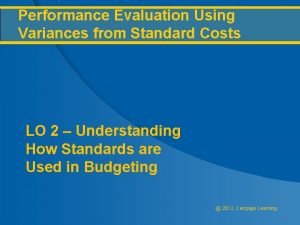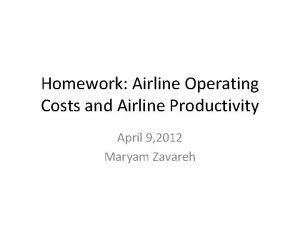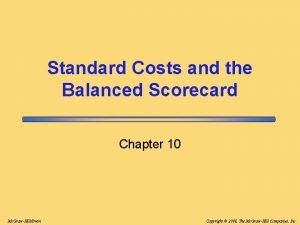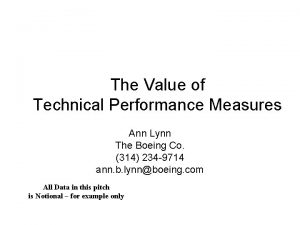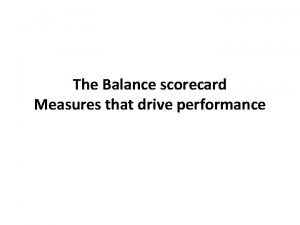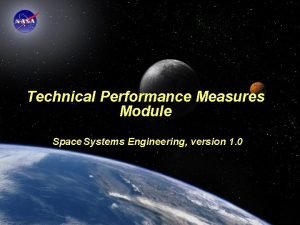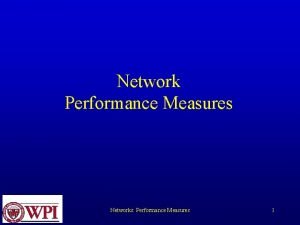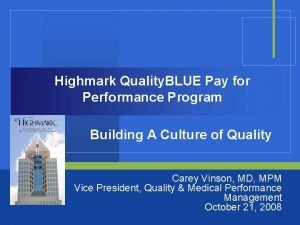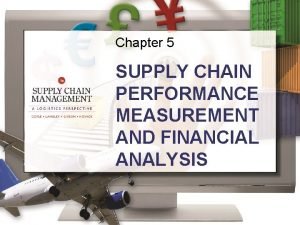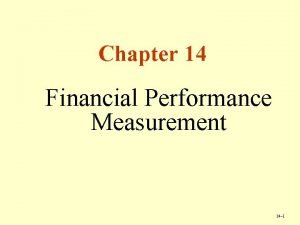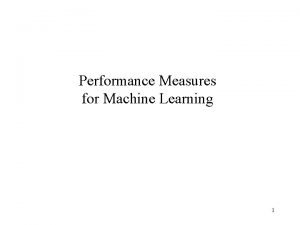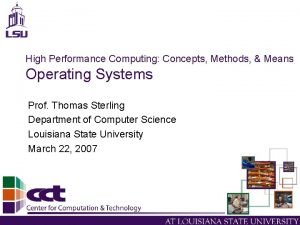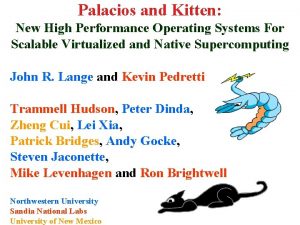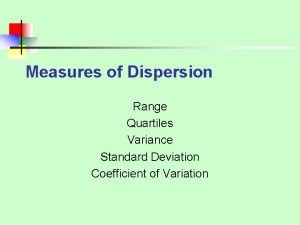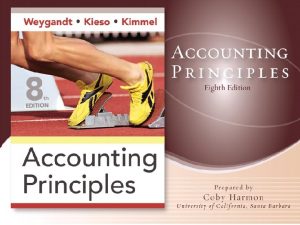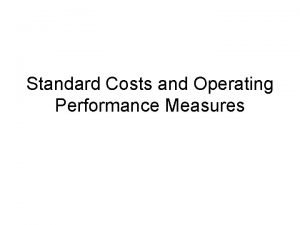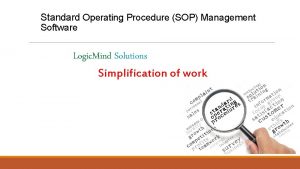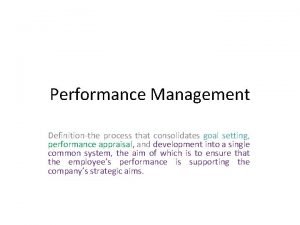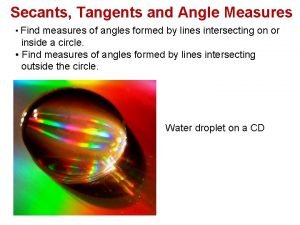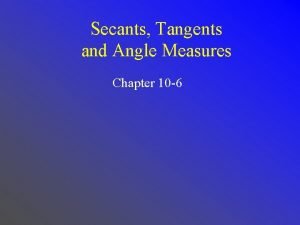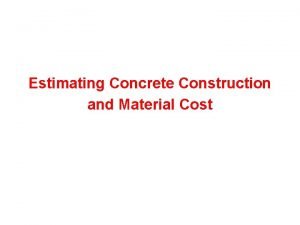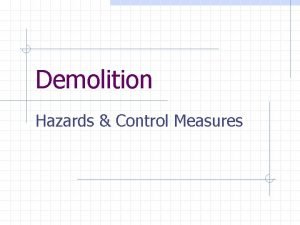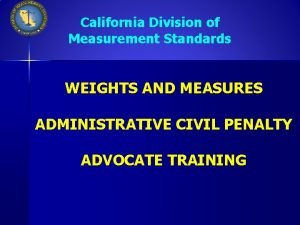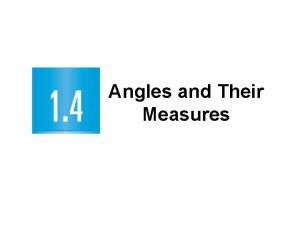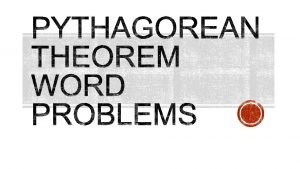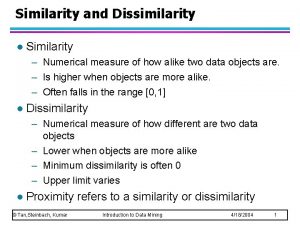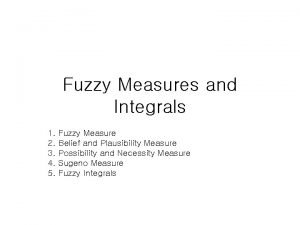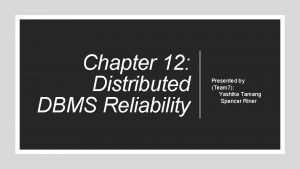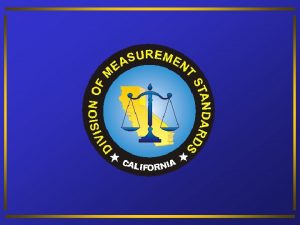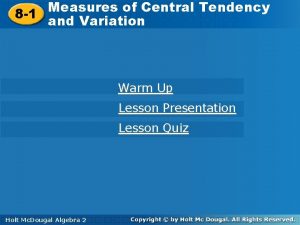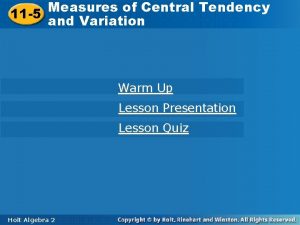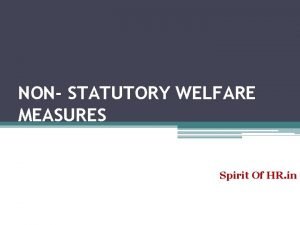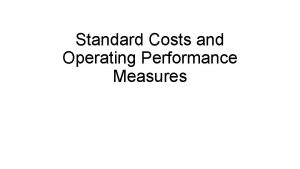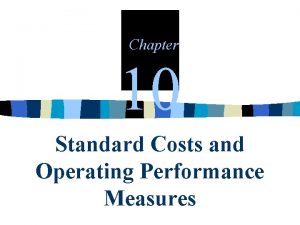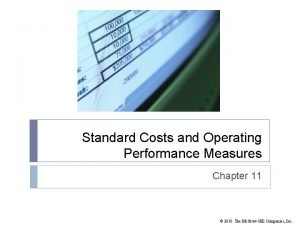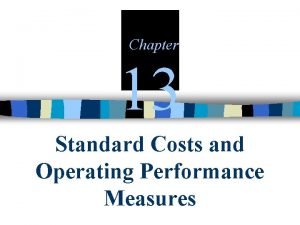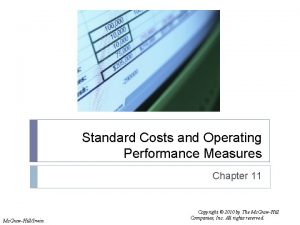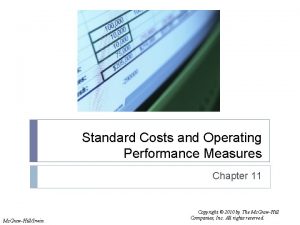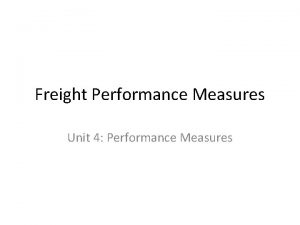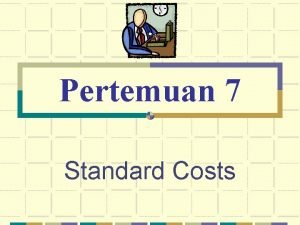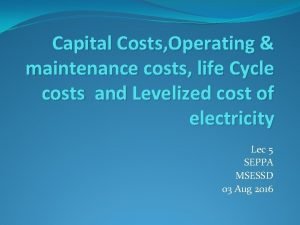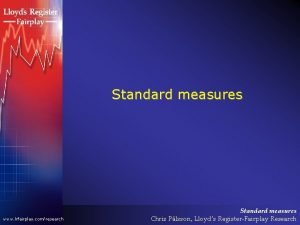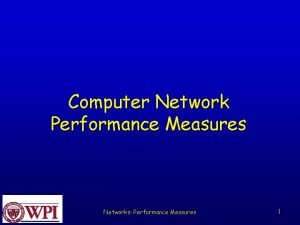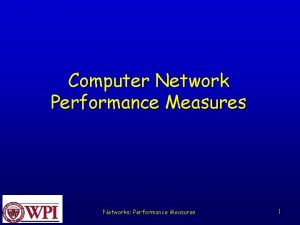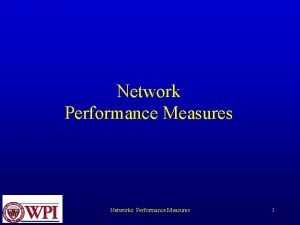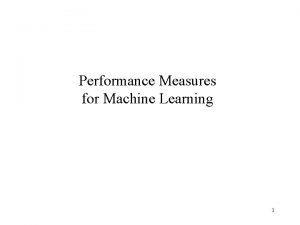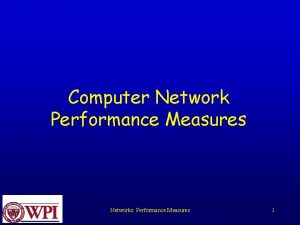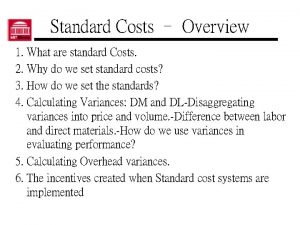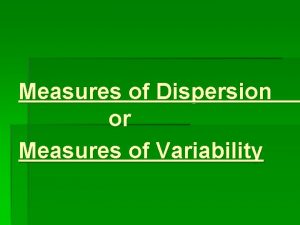Standard Costs and Operating Performance Measures Standard Costs















































- Slides: 47

Standard Costs and Operating Performance Measures

Standard Costs Standards are benchmarks or “norms” for measuring performance. In managerial accounting, two types of standards are commonly used. Quantity standards specify how much of an input should be used to make a product or provide a service. Price standards specify how much should be paid for each unit of the input. Examples: Firestone, Sears, Mc. Donald’s, hospitals, construction and manufacturing companies.

Key performance indicators VS Actual performance KPI Actual Variance Direct material 10. 00 per unit 11. 00 (A) Direct labour 5. 00 per unit 5. 50 0. 50(A) Variable overhead 2. 00 per unit 2. 00 - Fixed overhead 1. 00 per unit 1. 00 - Full cost 18. 00 per unit 18. 50

Standard Costs Amount Deviations from standards deemed significant are brought to the attention of management, a practice known as management by exception. Standard Direct Labor Direct Material Type of Product Cost Manufacturing Overhead

Variance Analysis Cycle Identify questions Receive explanations Take corrective actions Conduct next period’s operations Analyze variances Prepare standard cost performance report Begin

PDCA P=PLAN D=DO C=CHECK A=ACTION

Setting Standard Costs Accountants, engineers, purchasing agents, and production managers combine efforts to set standards that encourage efficient future operations.

Setting Standard Costs Should we use ideal standards that require employees to work at 100 percent peak efficiency? Engineer I recommend using practical standards that are currently attainable with reasonable and efficient effort. Managerial Accountant

Setting Direct Material Standards Price Standards Quantity Standards Final, delivered cost of materials, net of discounts. Summarized in a Bill of Materials.

Setting Standards Six Sigma advocates have sought to eliminate all defects and waste, rather than continually build them into standards. As a result allowances for waste and spoilage that are built into standards should be reduced over time.

Setting Direct Labor Standards Rate Standards Time Standards Often a single rate is used that reflects the mix of wages earned. Use time and motion studies for each labor operation.

Setting Variable Manufacturing Overhead Standards Rate Standards Quantity Standards The rate is the variable portion of the predetermined overhead rate. The quantity is the activity in the allocation base for predetermined overhead.

Price and Quantity Standards Price and quantity standards are determined separately for two reasons: The purchasing manager is responsible for raw material purchase prices and the production manager is responsible for the quantity of raw material used. The buying and using activities occur at different times. Raw material purchases may be held in inventory for a period of time before being used in production.

A General Model for Variance Analysis Price Variance Difference between actual price and standard price Quantity Variance Difference between actual quantity and standard quantity

A General Model for Variance Analysis Price Variance Materials price variance Labor rate variance VOH rate variance Quantity Variance Materials quantity variance Labor efficiency variance VOH efficiency variance

A General Model for Variance Analysis Actual Quantity × Actual Price Actual Quantity × Standard Price Variance Standard Quantity × Standard Price Quantity Variance

Standard Cost Card – Variable Production Cost A standard cost card for one unit of product might look like this:

Actual results for the month of March Actual production 5000 units Actual material used and purchased 17500 Kg Actual material cost Rs. 66500. 00 Labour hours produced 11250 hours Labour cost incurred Rs. 160312. 5 Variable overhead Rs. 28125. 00 Calculate all possible variances from the pre cost standard

Variance analysis Ultra Shine Company manufactures a cleaning solvent. The company employs both skilled and unskilled workers. The standard and actual material and labor information is presented below. Budgted production sales 60000 units. Standard: Material A: 30. 25 gallons @ Rs. 1. 25 per gallon = 37. 80 Skilled Labor: 4 hours @ Rs. 12 per hour = 48. 00 Variable production overhead 4 hours @ Rs. 3. 00 per hour= 12. 00 Fixed production overhead = 05. 00 Full cost per unit = 102. 80 Profit margin per unit = 40. 00 Selling price = 142. 80 Post order costing: Material A: 10, 716 gallons purchased and used @ Rs. 1. 50 per gallon Skilled labor hours: 1, 950 @ Rs. 11. 90 per hour Variable production cost Rs. 7800. 00 Fixed production overhead cost Rs. 310, 000. 00 During the current month Ultra Shine Company manufactured 500 55 gallon drums and total revenue earned Rs. 7, 508, 250. 00. Calculate all possible variances

Achieving the excellence in process improvement Six sigma Kaizon “Improvment change for the better” Kaizon is the philosophy of the companyto achieve the process excelle nce to improve the financial indicators . Continues improvement is the rule of the game. Team, change in attitudes, participating, quality and process improvement circle, brainstorming, empowerment are the key value drivers of a Kaizon culture. Eliminate defects Six sigma is looking at two methodlogies to elimiante the wastage DMAIC= Define, measure, analysis, improve and control OR DMADV= Define, measure, analysis, design and control https: //www. youtube. com/watch? v=il. DAYBR 5 s. QU

Planning and Operating Variances • Explaining the causes of variances is a key step in variance analysis. In some cases the cause is purely operational (e. g. the price of raw materials went up due to market shortages) but in some cases the cause is due to poor budgeting and planning (e. g. we used an out of date price list when setting the standard cost of materials). • Detail analysis of the variances leads to better understand the planning errors and the operational errors. • Else all the planning errors are accounted as a operational inefficiencies of labors, purchasing and the production. • Revision of the original budget or standard lead to planning variances.

Continue…….

Illustration 1 - Revising the standard Example: at the begging of 20 X 0, WB ltd set a standard marginal cost for its major product of Rs. 25 per unit. The standard cost is recalculated once each year. Actual production costs during August 20 X 0 were Rs. 304, 000, when 8, 000 units were made. With the benefit of hindsight, the management of WB ltd realizes that a more realistic standard cost for current condition would be Rs. 40 per unit. The planned standard cost of Rs. 25 is unrealistically low. Calculate the planning and operational variances.

Question 2: total planning and operational variances Suppose a budget is prepared which includes a raw materials cost per unit of product of Rs. 2 (2 kg of copper at Rs. 1 per kg). Due to a rise in world prices for copper during the year, the average market price of copper rises to Rs. 1. 50 per kg. During the year, 1000 units were produced at a cost of Rs. 3, 250 for 2, 200 kg of copper. Calculate the planning and operational variance Quetion 3: planning variances and sub- variances The standard materials cost of a product is 3 kg. Rs. 1. 50 per Kg=Rs. 3. 50. Actual production of 10, 000 units used 28, 000 kg at a cost of Rs. 50, 000. In retrospect it was realized that the standard materials cost should have been 2. 5 kg per unit at a cost of Rs. 1. 80 per kg (so that the total cost per unit was correct) Calculate the planning and operational variances in as much detail as possible

Budgets What is a budget? – a plan – expressed in monetary terms – covering a future time period – based on a defined level of activity

Budgeting can be used as a planning tool by Management. Therefore primary phases of the budgeting are q Planning q Control

Why comprehensive budgeting Identify the organizational interrelated impact on the operational income, financial position and The cash flow.

Types of budget • Fixed – Defined period, usually 12 months by month, often beyond 12 months • Rolling – continuously updated, additional months added to the end of the period so that at any time there is always a 12 -month forward-looking budget, often beyond 12 months • Forecast – Revised mid-year , without changing original budget – ‘Forecast’ sometimes used interchangeably with budget


Budgeting and strategy Strategic planning ‘precedes budgeting and provides the framework within which the annual budget is developed. A budget is, in a sense, a one-year slice of the organization’s strategic plan’.

Components of the comprehensive budgeting


Purposes of budgeting • Implement strategy by allocating resources in line with strategic goals • Co-ordinate activities and assist in communication among different parts of an organisation • Motivate managers to achieve targets • Provide a means to control activities • Evaluate and business unit performance

Budget cycle 1. 2. Identify business objectives Forecast future conditions (1) general economic conditions, (2) industry trends, (3) market research studies, (4) anticipated advertising and promotion, (5) previous market share, (6) changes in prices, and (7) technological developments 3. 4. Develop detailed sales budgets by market segments, major customers and product groups Prepare production budgets for the goods or services needed to satisfy the sales forecast and maintain agreed levels of inventory.

Budget cycle (cont. ) 5. Prepare expense budgets by cost centre 6. Prepare capital expenditure budgets 7. Prepare cash forecasts and identify financing requirements 8. Prepare master budget (Income Statement, Balance Sheet and Cash Forecast) 9. Obtain Board approval of profitability and financing targets

The Master Budget • The Master Budget is a set of interrelated budgets that constitutes a plan of action for a specified time period. 36


Formats of the operational and financial budgeting

Production budget

Material usage budget

Labor budget

Factory overhead budget

ENDING FINISHED GOOD INVENTORY BUDGET

SELLING, GENARAL AND ADMINISTRATION BUDGET

CASH BUDGET

Budgeted income statement

Budgeted balance sheet
 Operating performance measures
Operating performance measures Performance evaluation using variances from standard costs
Performance evaluation using variances from standard costs Anova repeated measures
Anova repeated measures Airline operating costs
Airline operating costs Voev-inc
Voev-inc Technical performance parameters
Technical performance parameters The balanced scorecard measures that drive performance
The balanced scorecard measures that drive performance Technical performance measure
Technical performance measure Network performance measurement
Network performance measurement Highmarl true performance quality measures
Highmarl true performance quality measures Financial measures of supply chain performance
Financial measures of supply chain performance Starbucks performance measures
Starbucks performance measures Pipeline performance measures
Pipeline performance measures Performance measures for machine learning
Performance measures for machine learning High performance operating system
High performance operating system High performance operating system
High performance operating system What is the mean variance and standard deviation
What is the mean variance and standard deviation An income statement reporting variances from standard costs
An income statement reporting variances from standard costs Standerd costing
Standerd costing How standard costs are prepared
How standard costs are prepared Sofware sob demanda
Sofware sob demanda Bars rating scale
Bars rating scale Performance appraisal process
Performance appraisal process Jcids manual
Jcids manual Tablespoon abbreviation cooking
Tablespoon abbreviation cooking Standard error statistics
Standard error statistics Home language and standard language
Home language and standard language Mbo performance appraisal method
Mbo performance appraisal method Module 7 weights and measurements
Module 7 weights and measurements Finding segment lengths find the value of x
Finding segment lengths find the value of x Secant tangent angle
Secant tangent angle Secant tangent angle
Secant tangent angle Deficient demand and excess demand
Deficient demand and excess demand Dispensatory measures
Dispensatory measures Concrete weight per cubic foot
Concrete weight per cubic foot Divergence of darkness
Divergence of darkness Demolition hazards and controls
Demolition hazards and controls California weights and measures
California weights and measures Vertical angles
Vertical angles Finding segment lengths in circles
Finding segment lengths in circles A suitcase measures 24 inches long
A suitcase measures 24 inches long Similarity and dissimilarity in data mining
Similarity and dissimilarity in data mining Belief and plausibility measures in fuzzy
Belief and plausibility measures in fuzzy Local reliability protocols in distributed dbms
Local reliability protocols in distributed dbms California weights and measures
California weights and measures Measures of central tendency and variation
Measures of central tendency and variation Measures of central tendency and variation
Measures of central tendency and variation Statutory and non statutory welfare measures
Statutory and non statutory welfare measures
